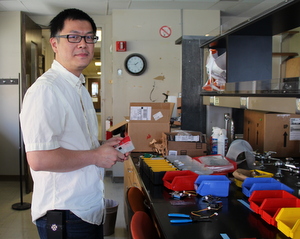If data indicated that you were exposed to harmful noise levels at work, would you do anything about it? If a personalized phone app suggested that a walk in the park tended to improve your mood, would you step out more often?
Such questions propel Edmund Seto. He's a University of Washington School of Public Health researcher and inventor who wants to heighten individuals' awareness of their surrounding micro environments, wherever they go, and in doing so, to learn whether the information spurs healthy changes in behavior.
The device he's building is like a FitBit for the bubble of space you occupy.

"It's about collecting and giving people information about the hazards they face personally. Air pollution is something we all understand, but this could apply to any toxin, to noise, and so on," said Seto, an associate professor of Enivornmental and Occupational Health Sciences. “You are willing to track yourself and understand something about your world, but" – he raises an eyebrow – "would you change?"
Seto is an associate professor of environmental and occupational health sciences. He measures people's exposures to hazards and assesses the associated health risks.
For years he downloaded and analyzed air-quality data collected by the federal government's refrigerator-size monitoring stations. The information tells which neighborhoods have worse air and whose residents' disease risk is prospectively higher.
"You live near this monitor, your exposure is X," Seto said of the reasoning. "It's simplistic. It doesn't say much about an individual's exposure because very few people spend all their time in one neighborhood."
He designed and crafted a low-cost, soda can-size sensor that clips to a belt and gauges air quality as well as noise, temperature and physical activity.
"Then you know their cumulative exposure, wherever they are. Wouldn't people want to know where the bulk of their air-pollution exposure comes from, especially if they're asthmatic or have COPD (chronic obstructive pulmonary disease)?"
Seto is like a fisherman figuring out how to use a newfangled net: His device and the smartphone app he developed can gather environmental data at a personal level. But what data is worth trawling for?
He's crossing the seas to find out.
The wearable sensors have been used in China to study air-quality's relationship with pediatric obesity and in the United States to see air pollution's effects on black women, who are prone to hypertension and diabetes. In Uganda the mobile monitors helped discern where children acquired intestinal parasites.
Seto also developed CalFit, a smartphone app with customizable short surveys that ping an owner at random times during the day. One survey asks, "Just before the beep, how happy were you feeling?" "How stressed were you feeling?" Finger-tap responses (from multiple choices), when overlaid with info about the time, place and activity, can derive associations about mood and environment.
CalFit has been used to survey Shanghai residents about the beverages they consume to gain insight about nutrition choices in urban and rural areas. In Europe the app showed associations between the natural environment and users' well-being.
The small projects, he hopes, will build confidence in his emerging sensors and apps.
"When you start developing new instruments, people don't have that data confidence yet; they want to establish how it compares to the federal instrument," Seto said.
But the excitement is hard to quell. Portable measurement can take scientific understanding to a new level of precision.
"It is just a matter of applying them to interesting studies. There are some fascinating challenges in urban planning and its impact on environmental health."
